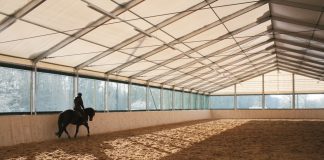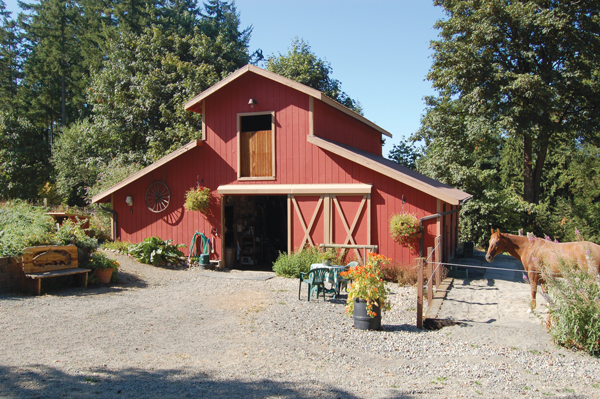
You drive a gas-saving vehicle. You bring cloth bags to the grocery store. You turn off the faucet while brushing your teeth. “Reduce, reuse, recycle” is something you take seriously, so you’re all about incorporating green, or eco-friendly, practices into your horsekeeping routine.
Managing Manure in Eco-Friendly Horsekeeping
Proper manure management is one of the biggest ways you can make horsekeeping greener. (No pun intended!) “The best thing a person can do for fly control is manure management, because then you get rid of the source of what’s feeding the flies,” says Alayne Blickle, creator/director of Horses for Clean Water, an internationally acclaimed environmental education program for horse owners. She and her husband own Sweet Pepper Ranch, an eco-sensitive guest ranch and horse motel in Nampa, Idaho.
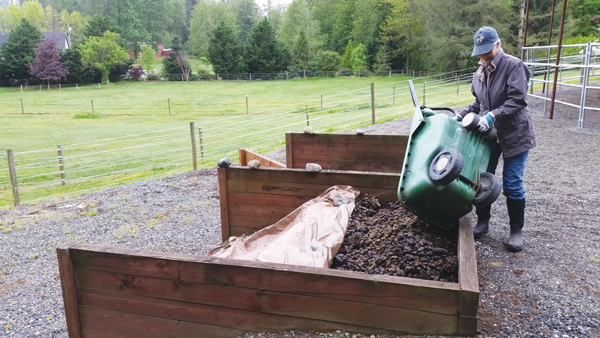
A healthy horse is literally a pooping machine, producing about 50 pounds of manure a day, or about eight tons per year. Piling up that manure in a big mound is neither earth-friendly nor practical. Additionally, runoff from a manure pile can contaminate nearby water sources, as well as leach into the soil and eventually make its way into drinking water.
The best approach to managing manure is to compost it on site or pay a service to have it hauled away regularly to a composting facility.
Nelson recommends asking the manager of your boarding barn to consider composting if this practice isn’t already in use.
For educational advice on composting, as well as any state regulations, check with your county extension office or conservation district.
“Every county has one; just Google the name of your county and ‘conservation district,’” says Blickle, whose own website offers a composting handbook.
“Composting is practical even if you have just one horse,” she continues.
“It generally takes three to six months from start to finish, and the composting process kills a majority of parasites, pathogens and weed seeds.”
Finished compost can be spread on pastures, yards and gardens to amend the soil.
“It makes plants healthier and more disease-resistant, and helps soil retain moisture longer,” says Blickle. “Research shows that one application has value for up to 10 years.”
Be Water-Wise
Water conservation is about much more than not wasting it, but that’s a great place to start.
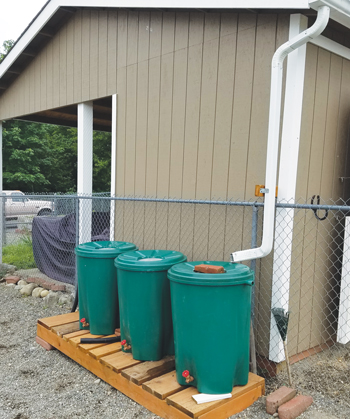
Watering your arena? Do so at night or early in the morning when evaporation is at its lowest. Collect rainwater in barrels and use it for cleaning chores and watering plants. (Don’t water horses with rainwater collected off a composite or shake roof because it may contain chemicals from roofing material.)
If you have an outdoor wash rack, situate it so that runoff cannot enter any natural water bodies. Use biodegradable shampoos, and avoid using chemical products in this area. Take steps to keep wash water from running off directly into the ground by planting a biofiltration strip composed of native grass/plants and soil around it.
Blickle advises installing rain gutters and roof runoff systems on all structures to divert rainwater away from high-traffic areas. This important step reduces mud and helps keep clean rainwater clean.
Eco-Friendly Horsekeeping: Save the Soil
“Protecting soil is just as important as protecting water,” says Nelson, who recommends mud grids in heavily-used areas around gates and water tanks. He’s had great success with Mud Control Grids from HAHN Plastics, made from 100 percent recycled plastic.
These large interlocking pieces hook together, forming a durable, porous surface that keeps soil in place and protects against erosion. (The company also makes sturdy 100 percent recycled plastic “lumber” for fencing and stall partitions, as opposed to pressure-treated wood, which contains chemicals that can leach into the environment.)
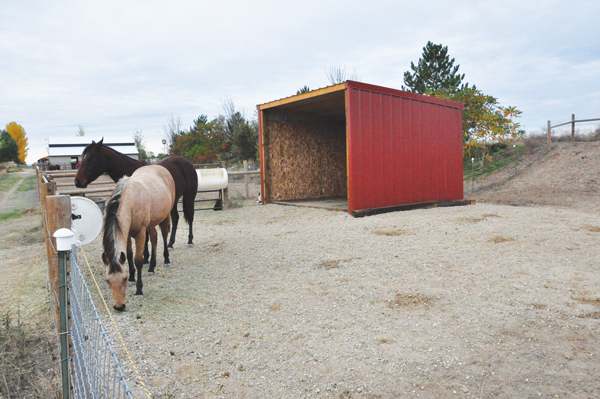
Horse hooves are notoriously hard on ground—especially when soil is wet. Both Nelson and Blickle strongly recommend that every horse facility have a paddock or sacrifice area/dry lot where horses can spend time outside but not on pasture. A general size recommendation is to allow at least 400 to 500 square feet per horse.
“A well-designed dry lot enables you to manage your facility sustainably no matter what Mother Nature throws at you,” says Nelson.
The sacrifice area should be on high ground, well away from any wetlands or water bodies, and surrounded by a buffer at least 25 to 30 feet wide of plants or grasses. To avoid mud, footing can be improved with sand, crushed rock or by using mud grids. A slight slope (2 to 5 percent) will allow rain to run off.
If your facility has no pasture, the dry lot gives horses a chance to exercise. If you do have pasture, the dry lot allows you to manage it effectively. As Blickle explains, you use it to keep horses off grass when soil is saturated and vulnerable to compaction and erosion, or during dry periods when grass is too short or stressed from drought.
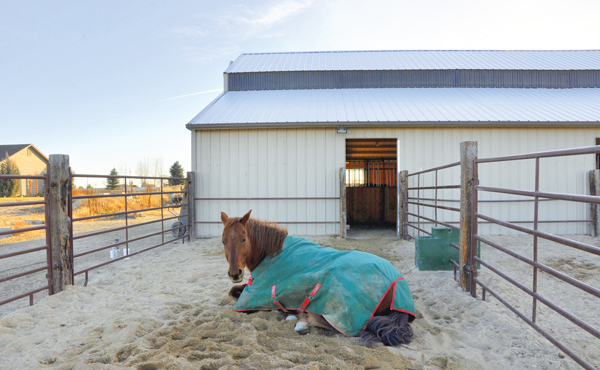
A dry lot is also excellent for managing easy keepers who gain too much weight on abundant grass, as well as horses with metabolic issues whose grass intake
must be restricted.
Dry lots can also be part of a rotational grazing program, allowing healthier grass to grow—which is the best way to cut down on weeds.
Speaking of weeds, mowing them before they go to seed may avoid the need for herbicides. You can make a non-chemical, vinegar-based weed killer (see “Easy
Homemade Weed Killer,” pg. 48) for spraying fencelines and around the barn.
Pest Control
Sanitation and good management practices go a long way toward reducing or even eliminating the need for insecticides or pesticides in your eco-friendly horsekeeping practices.
“Standing water, mud, and piled-up manure are great breeding grounds for mosquitoes and other insects,” says Nelson. “Addressing these issues is critical to any pest management strategy. If you don’t address these sources, you’ll never fix your pest problem.”
Pests (insects and rodents) are always seeking food sources, so do your best to remove them. This includes:
- Vigilant manure management (more on that next)
- Eliminating standing water sources
- Keeping brush/vegetation trimmed around barns and structures
- Sweeping up all spilled grain and feed daily
- Storing grain in sealed metal bins
- Not leaving out free-choice pet food at night
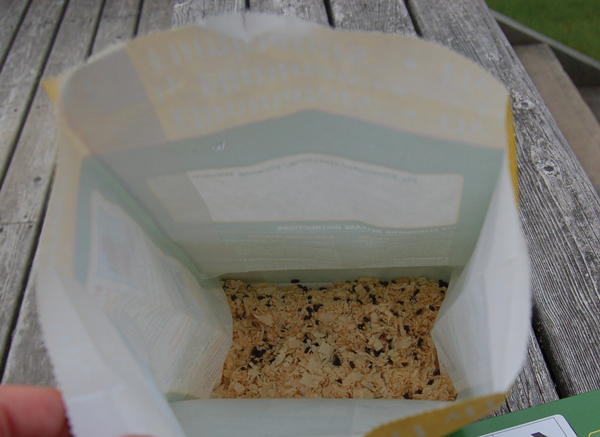
“In an ideal world, we’d be 100 percent chemical-free, but we have to be reasonable,” says Nelson. “A lot of the chemical-free solutions are effective but take time, so if you have a problem that has to be addressed, you may need to use some chemical strategies. The idea is to minimize that use.” He recommends chemical control as a last line of defense.
Don’t ignore mechanical methods of control. Fans in stalls can be quite effective at keeping mosquitoes and no-see-ums from landing on horses; these insects are poor fliers and can be deterred by the strong breeze of a fan.
Two effective insecticide-free methods for reducing the fly population are sticky tapes and fly traps. Hang sticky tapes in the barn out of horse reach and replace frequently.
Fly traps come in both reusable plastic containers or disposable bags. Sometimes
called “stinky traps”—for good reason!—these traps contain a bait attractant to which you add water. Flies are drawn to the smell, enter the trap and drown. (Hang traps outside the barn and away from horses because they attract flies.)
Physical barriers, including fly masks, fly sheets and fly boots can also prevent irritating pests from biting your horse—no chemicals involved.
Biological controls include the use of native fly parasites. These beneficial pest-eating insects are small, non-stringing wasps that lay their eggs in fly larvae, which destroys developing flies. The wasps themselves don’t become pests and don’t bother humans.
“There are several species of these wasps commercially available,” says Nelson.
You can buy them from a company that mails small batches of fly parasites to you. Scatter them around manure areas once a month or so throughout fly season.
For on-horse protection, try a natural fly repellent or make your own chemical-free option. There are plenty of recipes available, but be sure to avoid formulas that include petroleum products or household cleaning agents.
Remember, even if a product contains no insecticide or EPA-regulated ingredients, a sensitive- skinned horse may still have an allergic reaction. Apply to a small area and wait a few hours to be sure there’s no negative reaction, such as hives, before spraying your whole horse.
If you are using chemical fly repellent, make a point of applying it to your horse inside the barn instead of outdoors. “This helps avoid fly spray reaching beneficial insect habitat,” Blickle explains.
“Even bare ground can be a habitat for native pollinating insects.”
Good bugs—like bees and butterflies—will appreciate that.
Easy Homemade Weedkiller |
Meet the Experts of Eco-Friendly HorsekeepingClay Nelson was an environmental chemist working for the U.S. Environmental Protection Agency (EPA) when he started Sustainable Stables, LLC, an educational and planning service now based in Austin, Texas. He educates horse owners on eco-friendly horsekeeping practices and is a planning consultant for equine facilities. www.sustainablestables.com Alayne Blickle is a lifelong equestrian, educator, and photojournalist, and the creator/director of Horses for Clean Water, an internationally acclaimed environmental education program for horse owners. She has taught manure composting, pasture management, water conservation and other eco-friendly horsekeeping topics since 1990. She and her husband raise horses and hay on their Sweet Pepper Ranch in Nampa, Idaho. |
This article about eco-friendly horsekeeping appeared in the July 2019 issue of Horse Illustrated magazine. Click here to subscribe!




